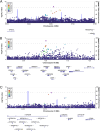Genome-wide association studies of Alzheimer's disease and related disorders stratified by sex, onset age, and Apolipoprotein E genotype reveal novel risk loci in African Americans
- PMID: 40708016
- PMCID: PMC12288278
- DOI: 10.1186/s13195-025-01782-y
Genome-wide association studies of Alzheimer's disease and related disorders stratified by sex, onset age, and Apolipoprotein E genotype reveal novel risk loci in African Americans
Abstract
Background: Alzheimer's disease (AD) risk variants have been identified in European ancestry cohorts that have stronger effects at certain ages, in individuals with a specific sex, or in those with specific isoforms of APOE, the strongest AD risk locus. However, sample sizes in African ancestry (AA) cohorts have been underpowered to perform stratified analyses.
Methods: We generated genome-wide association study datasets stratified by sex, age at onset (< 75 vs ≥ 75), and APOE-ε4 carrier status in AA cohorts from MVP and the Alzheimer's Disease Genetics Consortium (ADGC). Outcomes in MVP were AD and related dementias (ADRD; n = 4073 cases and 19,648 controls) and proxy dementia (i.e., reported dementia in a parent, n = 6216 cases and 21,566 controls) while ADGC analyses examined AD (n = 2425 cases and 5069 controls). The proxy dementia GWASs were included in the sex-stratified meta-analysis corresponding to the sex of the affected parent. The top genes were tested for differential expression in AA brain tissue.
Results: In addition to the APOE region, genome-wide significant associations were observed in an intergenic region near the EPHA5 gene (rs141838133, p = 2.19 × 10-8) in individuals with onset < 75 years, in GRIN3B near the known AD risk gene ABCA7 (rs115882880, p = 3.83 × 10-8) in females, and near TSPEAR (rs139130053, p = 4.27 × 10-8) in APOE-ε4 non-carriers. EPHA5 regulates glucose homeostasis, and ephrin receptors modify the strength of existing synapses in the brain and in pancreatic islets. It is unclear whether GRIN3B represents a locus distinct from ABCA7. Rs115882880 was a significant eQTL for GRIN3B but not ABCA7 in AA brain samples. TSPEAR regulates Notch signaling but has not been linked to neuronal function.
Conclusions: Age, sex, and APOE-stratified analyses of dementia in AA participants from two cohorts revealed potential new associations. Stratified analyses may yield critical information about the genetic heterogeneity underlying dementia risk and lead to advances in precision medicine.
Keywords: African Ancestry; Alzheimer’s disease; Genome-wide association study; RNA-sequencing; Stratified.
© 2025. This is a U.S. Government work and not under copyright protection in the US; foreign copyright protection may apply.
Conflict of interest statement
Declarations. Ethics approval and consent to participate: All participants provided informed consent to participate in their respective research projects. All work was overseen and approved by the IRBs at Boston University School of medicine and VA Boston. All research was conducted in accordance with the Declaration of Helsinki and the Belmont Report. Consent for publication: Not Applicable. Competing interests: The authors declare no competing interests.
Figures



Similar articles
-
African ancestry GWAS of dementia in a large military cohort identifies significant risk loci.Mol Psychiatry. 2023 Mar;28(3):1293-1302. doi: 10.1038/s41380-022-01890-3. Epub 2022 Dec 22. Mol Psychiatry. 2023. PMID: 36543923 Free PMC article.
-
Association of African Ancestry-Specific APOE Missense Variant R145C With Risk of Alzheimer Disease.JAMA. 2023 Feb 21;329(7):551-560. doi: 10.1001/jama.2023.0268. JAMA. 2023. PMID: 36809323 Free PMC article.
-
Extended genome-wide association study employing the African genome resources panel identifies novel susceptibility loci for Alzheimer's disease in individuals of African ancestry.Alzheimers Dement. 2024 Aug;20(8):5247-5261. doi: 10.1002/alz.13880. Epub 2024 Jul 3. Alzheimers Dement. 2024. PMID: 38958117 Free PMC article.
-
CSF tau and the CSF tau/ABeta ratio for the diagnosis of Alzheimer's disease dementia and other dementias in people with mild cognitive impairment (MCI).Cochrane Database Syst Rev. 2017 Mar 22;3(3):CD010803. doi: 10.1002/14651858.CD010803.pub2. Cochrane Database Syst Rev. 2017. PMID: 28328043 Free PMC article.
-
Plasma and cerebrospinal fluid amyloid beta for the diagnosis of Alzheimer's disease dementia and other dementias in people with mild cognitive impairment (MCI).Cochrane Database Syst Rev. 2014 Jun 10;2014(6):CD008782. doi: 10.1002/14651858.CD008782.pub4. Cochrane Database Syst Rev. 2014. PMID: 24913723 Free PMC article.
References
MeSH terms
Substances
Grants and funding
- I01BX005749/U.S. Department of Veterans Affairs
- I01BX005749/U.S. Department of Veterans Affairs
- I01BX005749/U.S. Department of Veterans Affairs
- I01BX005749/U.S. Department of Veterans Affairs
- I01BX005749/U.S. Department of Veterans Affairs
- I01BX005749/U.S. Department of Veterans Affairs
- U01 - AG032984/NH/NIH HHS/United States
- U01 - AG032984/NH/NIH HHS/United States
- U01 - AG032984/NH/NIH HHS/United States
- U01 - AG032984/NH/NIH HHS/United States
- U01 - AG032984/NH/NIH HHS/United States
- U01 - AG032984/NH/NIH HHS/United States
- U01 - AG032984/NH/NIH HHS/United States
- U01 - AG032984/NH/NIH HHS/United States
LinkOut - more resources
Full Text Sources
Medical
Miscellaneous

